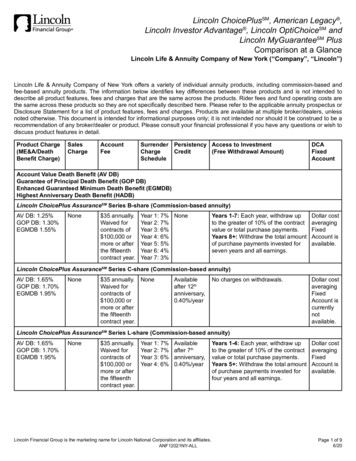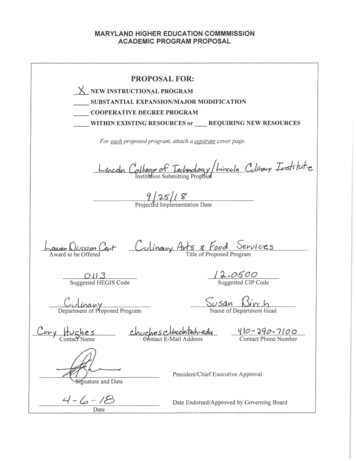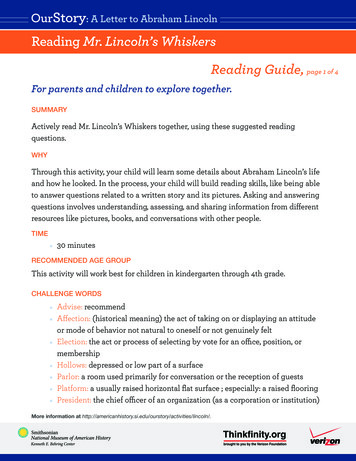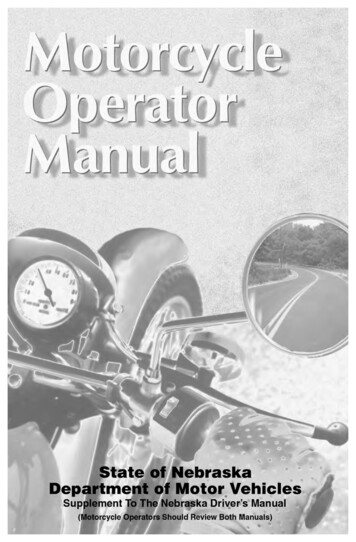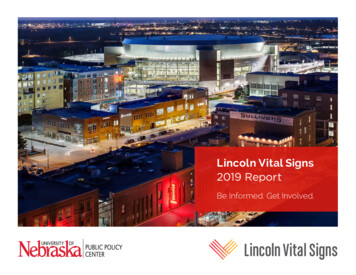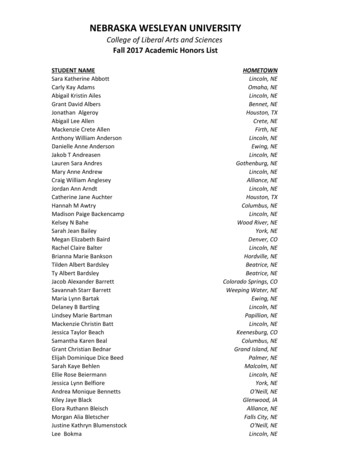
Transcription
Learning Outdoors at LincolnResources for Teachers and StudentsLincoln School PTO Landscape Committee2004 - 05
Lincoln School PTO Landscape Committee19 Kennard RoadBrookline MA 02445October 2004
Contents248121416181920IntroductionSchoolyard GardenHedge Road Natural AreaTrees at Lincoln SchoolTree Inventory ProjectArbor DayNeighborhood HistoryCommunity ServiceContact the Landscape Committee1
IntroductionThe landscape around Lincoln is an extraordinary asset for the school, the neighborhood and for all of Brookline. Few placesoffer so rich a variety of open spaces withinwalking distance or through a short ride onpublic transport. The opportunities forchildren to learn from these places are verygreat.Right in our neighborhood we have:- The Emerald Necklace parks along theMuddy River, a masterpiece of landscapearchitecture designed by Frederick LawOlmsted in the late 1900’s- Olmsted’s own house and office on WarrenSt., now a National Historic Site- The historic Old Burying Ground, acrossWalnut St.- A one-acre “urban wild” nature area at theend of Hedge Road- Our own beautiful school grounds, a 1992re-design of a property dating to the early1800’s- A schoolyard garden for Lincoln students2Slightly farther afield but still in Brooklineor in nearby parts of Boston:- Three nature sanctuaries with wetlands,forests and wildlife; one accessible by the T- Allandale Farm, the last working farm inBoston- Many other interesting places such as LarzAnderson Park, Longwood Mall, and our ownClark Park (once a glass-greenhouse nursery) and Robinson Playground (once a carbarn for the neighborhood streetcars)- The Arnold Arboretum- The Mass. Audubon Center, in Boston
In our mission to serve teachers and students at Lincoln, the PTO LandscapeCommittee focuses on making the most ofthe outdoor resources closest to school.Over the past four years we have worked onfinding learning opportunities in the landscape of this neighborhood, and we’ve alsolearned about what it takes to make outdoor projects happen during the course ofthe school day. We know that there isalready much for teachers and students toaccomplish during the year, so that anything we propose to add ought to be easyfor teachers, interesting for students andgood for the neighborhood and the town.The following pages are an album of someof our recent projects and current ideas, andwe offer them to the school community as aresource book for the school year. We hopethat what you find here will make it easier toget outdoors and to find interesting things tolearn when you get there.3
Schoolyard GardenThe garden is located in a sunny spot alongthe side of the 6th grade wing. It wascreated in August 2003, by removing anarea of grass and stony subsoil and replacing it with about a foot of loam. There weretwo planting projects in 2003 - 2004,shown on the following pages.4Our garden is a trapezoid measuring about24 feet by 11 feet, or roughly 250 squarefeet. It has a stepping-stone path down themiddle and a water tap at the building wall.There is usually a hose at the tap duringwarm weather.To keep track of who has planted what inthe garden, the Landscape Committeemaintains a garden map on the wall of theschool office; each class or group thatplants should locate and mark its work onthe map so that the next group will know toplant somewhere else.
Fall 2003: Bulb planting by the entire 4thgrade. Students planted tulip and daffodilbulbs along the ramp railing, and garliccloves in a patch along the wall. Theflower bulbs will come up each spring; thegarlic came up in spring 2004 and washarvested in August. Each garlic cloveproduced an entire plant with a full bulb,which can then be re-divided for re-plantingin the fall.5
Tools: The school now has a good variety ofgardening tools, in a range of sizes. Theyare stored in the closet at the left entrancevestibule to the theater (behind the elevator). There are also some baskets, a largebarrel, and more hoses. Hose keys for theoutdoor hose taps are available through the6Landscape Committee and the school custodian. There are many of the small handtrowels since these can be useful for workwith potted plants or for any outdoor projector field trip that involves digging, such astrips to the beach.
Ms. Dungan’s 2nd graders planted aWampanoag vegetable patch in June 2004,with corn, beans and squash in traditionalcircle patterns. This spring project helpedthe students recall what they had learnedabout native American agriculture the previous fall, and will now serve this year’s second graders when they study the sametopic. Some ears of corn were eaten bysquirrels, but the rest was saved, and students will harvest the squash and beans inOctober.7
Hedge Road Natural AreaThis “urban wild” natural area is a one-acreproperty owned by the Massachusetts Highway Department. Lincoln School has anexclusive use permit, granted in the fall of2003. MHD seems to have bought theproperty long ago for the purpose of straightening out Route 9, but has not done so.The land is forested and contains a seasonalwetland, which is a fragment of the stream8that once flowed from a wetland (now theReservoir) through the Lincoln grounds anddown to the Muddy River in Brookline Village. There are both native and non-native“invasive” or exotic plants to be found.There is also some trash and debris throughout. A chain link fence encloses the property along the entire Route 9 edge, andalong parts of Warren St. and Hedge Road.
The Landscape Committee sought the usepermit for this land in response to teacherinquiries about nearby areas suitable foroutdoor study or field trips. Brookline hasmany parks and open spaces, but getting agroup of students to them requires transportation planning, and time. The MHDproperty has the advantage of being lessthan 500 feet from the school building.Perhaps more important, students may dothings there that they could not do in anature sanctuary or a maintained landscape(like a park or a school playground).Within reasonable limits and with teachersupervision, students may dig in the soil,take small plant samples, pick apart olddecaying logs, or do other similar investigations. Because the area is not cultivated ormaintained, a great variety of plants can beobserved throughout their entire annualcycles. Teachers are invited to meet withthe Landscape Committee and Mrs. Shea toreview other proposed activities, to makesure they conform to the terms of the permit. Students must be accompanied by ateacher when visiting the property.9
The MHD property abuts two residential lotson the south, including the purple house onWarren St.; both are currently owned by Ms.Anne Burns. Ms. Burns’ undeveloped lotthen adjoins the Jensens’ lot, which is thefirst house on the south side of Hedge Road.The Landscape Committee has advised bothneighbors of the possibility of teachers andstudents being present on the MHD landfrom time to time. Ms. Burns has kindlyoffered Lincoln student groups access to herundeveloped lot as well, since it is in a10similar natural state. The Jensens haveasked visitors to enter the area via theirdriveway, rather than by stepping over thelow stone wall which runs along Hedge Roadto the chain link fence near the highway.Visitors entering from this driveway willbriefly cross the undeveloped Burns lot,whose boundary with the MHD land approximately follows the stream valley that runsparallel to Route 9 and is one of the majorfeatures of the area.
HEDGE ROADNATURAL 1
Trees at Lincoln SchoolTrees are among the most notable featuresof the landscape around Lincoln. They forma constantly changing backdrop to outdooractivities throughout the school year, andtheir great variety of species and sizes offersmany opportunities for learning. Over thelonger term, the trees are constantly growing, and some die or become damaged, sothat over the eight or ten years of astudent’s time at Lincoln this part of thelandscape changes measurably. We hope tostimulate thinking about how local stewardship can manage this kind of change, bysupporting projects where students observe,plant and care for trees.12
In fall 2002 the Landscape Committeedecided to try to stir up interest in our treesby adding a display of leaf samples to thePumpkinfest pumpkin-sales area. We tookleaves from about twenty Lincoln trees and,with the help of two primary-grade students, laminated them onto some scraps ofcorrugated cardboard with the names andlocations of the trees written on the back.Titled “Turn Over a Lincoln Leaf”, thishome-made guessing game has provedsurprisingly durable and helped initiate atree-data collection project conducted overthe next two years, shown on the followingpages.13
Tree Inventory ProjectFrom 2002 through 2004, 7th and 8th gradescience students observed and mapped allof the trees on the school grounds, classifying them by species, size, condition andother characteristics. Temporary ceramictile number tags, created in 7th grade artclasses, established a unique number codefor each tree and helped control the datacollection work during the two years. The14town Tree Warden coordinated the projectfrom the Town Hall end and met with students in the classroom. The data has nowbeen incorporated into the Town of BrooklineGeographic Information Systems database,which is used by the Parks & Open SpaceDivision to manage the thousands of publictrees in our streets and parks.
15
Arbor DayThe 8th grade class of 2001 launched ArborDay by donating a tree for the schoolgrounds, and after four years it is now aLincoln tradition. Arbor Day is an annualschool-wide outdoor gathering accompaniedby art and music, readings, or other student16presentations. The program of spontaneousstudent offerings in 2004 was so extensivethat it may be time to expand the observance of Arbor Day beyond the end-of-theschool-day gathering, perhaps to includecommunity-oriented environmental projects.
The Arbor Day trees have now been labelledto identify their common names, botanicalnames and date of planting. To date, theyinclude:2001: Red maple (Acer rubrum), inside brick wall along Kennard Road2002: Tulip (Liriodendron tulipifera), in circle at west side of school (teachers’ parking)2003: American elm (Ulmus americana), inside brick wall at little doorway on Walnut St.2004: Sugar maple (Acer saccharum), at front entry circle outside music room windows17
Neighborhood HistoryThis is a detail of an 1884 map of theneighborhood around Lincoln School. Itwas published in Philadelphia as a page inan atlas, one volume in one of several seriesof atlases documenting property ownership,buildings, streets and railroads, and naturalfeatures in many parts of the United States.These were used by people in the real estateand insurance industries.At the center of the map is the old KennardHouse, now the Brookline Music School;Kennard Road and Cushing Road have notbeen built yet, but most of the other streetsin the neighborhood are there. Other landmarks such as the Reservoir, the First Parish18Church, the cemetery and the Boston andMaine Railroad (now the Riverside branch ofthe Green Line) can be seen. Many oldproperties that appear here are now dividedand gone; for example, the house and lot ofSamuel Clark occupy some of what is nowClark Court and Clark Park. In 1884 therewere still streams and ponds in this part oftown, including one that crossed what is nowthe Lincoln playground field and continueddown to join the Village Brook where theBrookline Hills T stop is now.The map hangs in the Library. It is framedunder plexiglas so that it can be taken outsafely for use in the classroom or outdoors.
Community ServiceBrookline has many openspaces beyond the LincolnSchool grounds, and someof them provide opportunities for community serviceby 7th and 8th grade students. Most common arethe seasonal park clean-ups,which are usually sponsoredby the “Friends” groupsaffiliated with individualparks or nature sanctuaries.As a member organization ofthe Brookline GreenspaceAlliance, the PTO Landscape Committee has manyconnections to the parkFriends groups and to otherlocal advocates for openspace; this helps keep usaware of communityprojects that can provideservice opportunities forstudents.19
Contact the Lincoln Landscape CommitteeThe Lincoln School Landscape Committe isa PTO committee with a focus on the schoolgrounds, outdoor learning and the environment. In addition to the learning programsand resources shown in this booklet, wework on outdoor construction and maintenance projects, and on creating partnershipsbetween the Lincoln community and theprofessional staff at Town Hall who areresponsible for the school grounds.To teachers: Please contact us if you wouldlike assistance bringing your classroom intothe outdoors at school, through any of theideas on the preceding pages or anythingelse you would like to try. We will be happyto meet with you and with your teachingaides and room parents. You can leave us anote in the Landscape Committee mailboxin the school office, or call us at the phonenumbers below.Randolph Meiklejohn (617) 739-0206Sudy Nally (617) 734-4568co-chairs for 2004-0520
Brookline MA 02445 October 2004. Introduction Schoolyard Garden Hedge Road Natural Area Trees at Lincoln School Tree Inventory Project Arbor Day Neighborhood History . Trees at Lincoln School Trees are among the most notable features of the landscape around Lincoln. They form


